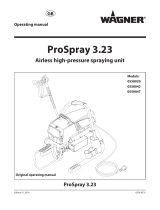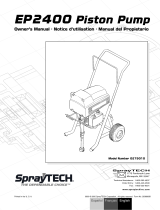
24 ProSpray 3.39
Safety Regulations
1. Safety regulations for Airless
spraying
This manual contains information that must be read and understood
beforeusingtheequipment.Whenyoucometoanareathathasoneof
the following symbols, pay particular attention and make certain to heed
the safeguard.
This symbol indicates a potential hazard that may cause
serious injury or loss of life. Important safety information
will follow.
This symbol indicates a potential hazard to you or to the
equipment. Important information that tells how to
prevent damage to the equipment or how to avoid
causes of minor injuries will follow.
A hazard symbol such as this one refers to a specific,
task-related risk. Be sure to heed the safeguard.
i
Notes give important information which should be given
special attention.
HAZARD: INJECTION INJURY
A high pressure stream produced by this equipment
can pierce the skin and underlying tissues, leading to
serious injury and possible amputation.
DO NOT TREAT AN INJECTION INJURY AS A
SIMPLE CUT! Injection can lead to amputation. See a
physician immediately.
The maximum operating range of the unit is 221 bar
(22.1 MPa, 3200 PSI) uid pressure.
PREVENTION:
• NEVERaimthegunatanypartofthebody.
• NEVERallowanypartofthebodytotouchtheuid
stream.DONOTallowbodytotouchaleakintheuid
hose.
• NEVERputyourhandinfrontofthegun.Gloveswill
not provide protection against an injection injury.
• ALWAYSlocktheguntrigger,shuttheuidpumpoff
and release all pressure before servicing, cleaning
the tip guard, changing tips, or leaving unattended.
Pressure will not be released by turning off the engine.
ThePRIME/SPRAYvalveorpressurebleedvalve
must be turned to their appropriate positions to relieve
system pressure.
• ALWAYSkeeptipguardinplacewhilespraying.The
tip guard provides some protection but is mainly a
warning device.
• NEVERuseaspraygunwithoutaworkingtriggerlock
and trigger guard in place.
• ALWAYSremovethespraytipbeforeushingor
cleaning the system.
• Thepainthosecandevelopleaksfromwear,kinking
and abuse. A leak can inject material into the skin.
Inspect the hose before each use.
• Allaccessoriesmustberatedatorabovethe
maximum operating pressure range of the sprayer.
This includes spray tips, guns, extensions, and hose.
NOTE TO PHYSICIAN:
Injection into the skin is a traumatic injury. It is
important to treat the injury as soon as possible. DO
NOT delay treatment to research toxicity. Toxicity is a
concern with some coatings injected directly into the
blood stream. Consultation with a plastic surgeon or
reconstructive hand surgeon may be advisable.
HAZARD: EXPLOSION OR FIRE
Solvent and paint fumes can explode or ignite. Severe
injury and/or property damage can occur.
PREVENTION:
• Provideextensiveexhaustandfreshairintroduction
to keep the air within the spray area free from
accumulationofammablevapors.
• Avoidallignitionsourcessuchasstaticelectricity
sparks,electricalappliances,ames,pilotlights,hot
objects, and sparks from connecting and disconnecting
power cords or working light switches.
• Plasticcancausestaticsparks.Neverhangplastic
to enclose spray area. Do not use plastic drop cloths
whensprayingammablematerials.
• Alwaysushunitintoseparatemetalcontainer,atlow
pump pressure, with spray tip removed. Hold gun
rmlyagainstsideofcontainertogroundcontainerand
prevent static sparks.
• Donotsmokeinsprayarea.
• Fireextinguishermustbepresentandingoodworking
order.
• Placesprayeratleast6.1m(20feet)fromthespray
object in a well ventilated area (add more hose if
necessary). Flammable vapors are often heavier than
air. Floor area must be extremely well ventilated. The
pump contains arcing parts that emit sparks and can
ignite vapors.
• Theequipmentandobjectsinandaroundthespray
area must be properly grounded to prevent static
sparks.
• Useonlyconductiveorearthedhighpressureuid
hose. Gun must be earthed through hose connections.
• Powercordmustbeconnectedtoagroundedcircuit
(electric units only).
• Theunitmustbeconnectedtoanearthedobject.Use
the green earthing wire to connect the unit to a water
pipe, steel beam, or other electrically earthed surface.
• Followmaterialandsolventmanufacturer’swarnings
andinstructions.Befamiliarwiththecoatingmaterial’s
MSDSsheetandtechnicalinformationtoensuresafe
use.
• Donotusematerialswithaashpointbelow21°C
(70°F).Flashpointisthetemperatureatwhichauid
can produce enough vapors to ignite.
• Uselowestpossiblepressuretoushequipment.
PE
0 bar






















